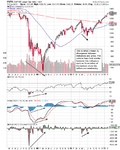isatrader
Senior member
- Messages
- 2,964
- Likes
- 135
Good!
But volume I dont use. Volume doesnt tell anything. For every sll there is a buyer and conversely. So volume shows volume of exchange not direction or conviction as some people tend to believe. Indeed certain high volume after some days of rally could be smartmoney distributing..and so certain large volume after selloffs means accumulation by them. It is quite tricky.
It is possible to know when market turns or is turning. That is a trader for you. Market trends about 15% and ranges for about 80%. How can one make money if you cannot find inflexion points? Or trade ranges..which is bsically trading off turning points. A market can trade in ranges for months! It is rather impossible to tell if a move is a trend b/cos if it is not the trader ends up buying top of a range 🙂 SNP500 is widely followed and inflexion points ar easily known...trade other stocks in that contxt by selling tops and buying bottoms. Except for small caps..capitalised stocks follow the market
See the attached S&P 500 weekly chart. It shows a very obvious example of what I mean when I say a divergence between price and volume. The volume bars as you say don't show it, but force index which is a different way of representing volume does very clearly. This chart shows why I think divergences in indicators are useful as a divergence on a weekly timeframe between indicators and price shows when the strength of a trend is weakening. I use it with good results on a daily and weekly timeframe by looking for divergences on the weekly timeframe, and then moving to the daily and intraday timeframes to gauge price action. It is a method that I find useful, Like everything in this game it won't suit everyone, but it helps me with my decision making process.
Attachments
Last edited:



